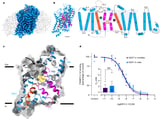Breakthrough Study Reveals How Cocaine Hijacks Brain's Dopamine Transporter, Paving Way for New Treatments
August 7, 2024
Recent studies from the University of Copenhagen have provided crucial insights into how cocaine binds to the dopamine transporter (DAT), revealing molecular-level details about its inhibition.
One of the studies highlights that MRS7292 binds deeply within the hDAT structure, creating a unique pharmacological profile that sets it apart from other transporters like hSERT.
Utilizing cryo-electron microscopy, researchers have detailed the binding mechanisms of various molecules to DAT, enhancing our understanding of its structure and function.
The human dopamine transporter is essential for dopamine transport, leveraging sodium and chloride gradients to facilitate substrate uptake.
Dopamine, often referred to as the 'feel-good hormone,' is regulated by DAT, which plays a critical role in mood, reward, and motivation.
Cocaine disrupts DAT's ability to regulate dopamine levels, which can lead to an inability to differentiate between pleasurable and non-pleasurable experiences.
Professor Claus Løland has emphasized the potential for developing medical treatments for cocaine abuse, which could significantly aid individuals battling addiction.
The overarching goal of this research is to support the creation of targeted pharmaceuticals for conditions linked to DAT dysfunction, including addiction.
Harald H. Sitte from the Medical University of Vienna has underscored the importance of these findings for future therapeutic applications.
These findings are pivotal for understanding dopamine imbalances that contribute to various brain disorders, including Parkinson's and psychological issues.
Published in the journal Nature, this study highlights the significance of understanding cocaine's effects on the brain and its implications for treatment.
For those interested in further details, the source data related to this study can be accessed through a linked paper.
Summary based on 4 sources
Get a daily email with more Science stories
Sources

Nature • Aug 7, 2024
Structure of the human dopamine transporter and mechanisms of inhibition
Nature • Aug 7, 2024
Dopamine reuptake and inhibitory mechanisms in human dopamine transporter
Medical Xpress • Aug 7, 2024
Cocaine discovery could pave way for treatment for substance abuse